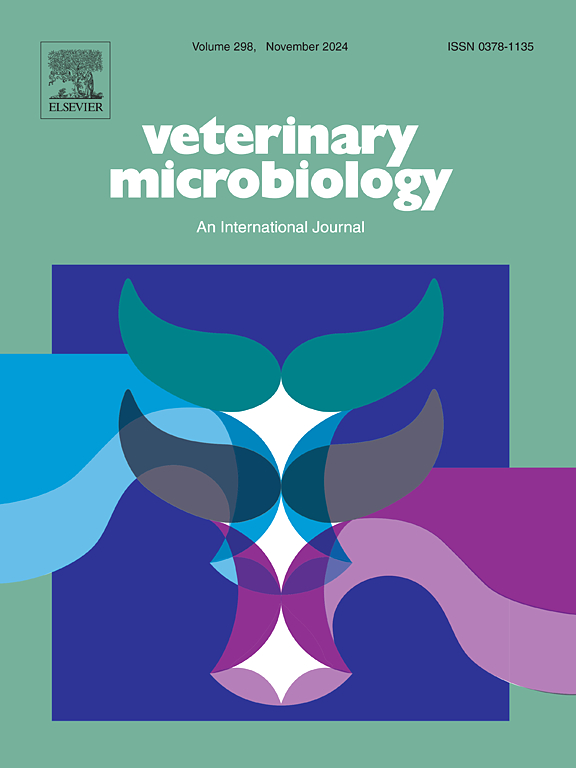Microbiome and metabolome alterations in calves with enterohemorrhagic Escherichia coli and dyspeptic diarrhea
IF 2.4
2区 农林科学
Q3 MICROBIOLOGY
引用次数: 0
Abstract
Enterohemorrhagic Escherichia coli (EHEC) and dyspeptic diarrhea are significant health concerns in calves, leading to substantial economic losses in the livestock industry. This study investigated the impact of EHEC infection and dyspeptic diarrhea on calf health, focusing on blood parameters, fecal microbiota, and metabolite profiles. Thirty-two holstein calves were divided into three groups: healthy group (C Group), EHEC-infected group (E Group), and indigestion-induced diarrhea group (I Group). Significant alterations in diarrheic calves were noted in peripheral blood parameters, including hematological, biochemical, and blood gas indices. And then fecal microbiota analysis revealed decreased diversity, with reduced Actinobacteria and increased Proteobacteria and Fusobacteriota in E and I group. Metabolomic profiling showed significant reductions in organic acids and lipids in diarrheic calves. The study concludes that microbial and metabolic alterations play critical roles in the pathogenesis of EHEC- and indigestion-induced diarrhea, with Scorzoside identified as a potential biomarker for differentiating healthy calves from those with diarrhea. These findings provide insights for designing targeted interventions to enhance gut health and reduce disease burden in the livestock.
肠出血性大肠杆菌和消化不良腹泻犊牛的微生物组和代谢组改变
肠出血性大肠杆菌(EHEC)和消化不良腹泻是犊牛的重大健康问题,给畜牧业造成重大经济损失。本研究调查了肠出血性大肠杆菌感染和消化不良性腹泻对犊牛健康的影响,重点关注血液参数、粪便微生物群和代谢物谱。将32头荷斯坦犊牛分为健康组(C组)、肠出血性大肠杆菌感染组(E组)和消化不良腹泻组(I组)。腹泻犊牛外周血参数发生显著变化,包括血液学、生化和血气指标。粪便菌群多样性分析显示,E组和I组放线菌群减少,变形菌群和梭菌群增加。代谢组学分析显示腹泻小牛的有机酸和脂质显著减少。该研究得出结论,微生物和代谢改变在肠出血性大肠杆菌和消化不良引起的腹泻的发病机制中起着关键作用,Scorzoside被认为是区分健康犊牛和腹泻犊牛的潜在生物标志物。这些发现为设计有针对性的干预措施以增强肠道健康和减轻牲畜的疾病负担提供了见解。
本文章由计算机程序翻译,如有差异,请以英文原文为准。
求助全文
约1分钟内获得全文
求助全文
来源期刊

Veterinary microbiology
农林科学-兽医学
CiteScore
5.90
自引率
6.10%
发文量
221
审稿时长
52 days
期刊介绍:
Veterinary Microbiology is concerned with microbial (bacterial, fungal, viral) diseases of domesticated vertebrate animals (livestock, companion animals, fur-bearing animals, game, poultry, fish) that supply food, other useful products or companionship. In addition, Microbial diseases of wild animals living in captivity, or as members of the feral fauna will also be considered if the infections are of interest because of their interrelation with humans (zoonoses) and/or domestic animals. Studies of antimicrobial resistance are also included, provided that the results represent a substantial advance in knowledge. Authors are strongly encouraged to read - prior to submission - the Editorials (''Scope or cope'' and ''Scope or cope II'') published previously in the journal. The Editors reserve the right to suggest submission to another journal for those papers which they feel would be more appropriate for consideration by that journal.
Original research papers of high quality and novelty on aspects of control, host response, molecular biology, pathogenesis, prevention, and treatment of microbial diseases of animals are published. Papers dealing primarily with immunology, epidemiology, molecular biology and antiviral or microbial agents will only be considered if they demonstrate a clear impact on a disease. Papers focusing solely on diagnostic techniques (such as another PCR protocol or ELISA) will not be published - focus should be on a microorganism and not on a particular technique. Papers only reporting microbial sequences, transcriptomics data, or proteomics data will not be considered unless the results represent a substantial advance in knowledge.
Drug trial papers will be considered if they have general application or significance. Papers on the identification of microorganisms will also be considered, but detailed taxonomic studies do not fall within the scope of the journal. Case reports will not be published, unless they have general application or contain novel aspects. Papers of geographically limited interest, which repeat what had been established elsewhere will not be considered. The readership of the journal is global.
 求助内容:
求助内容: 应助结果提醒方式:
应助结果提醒方式:


